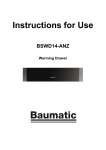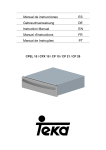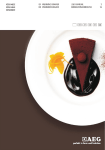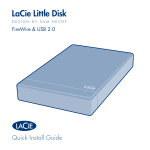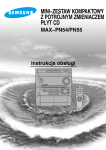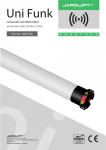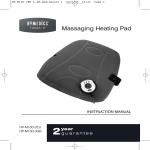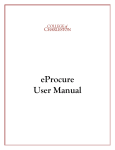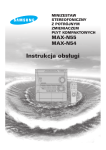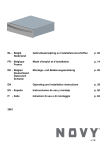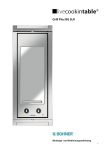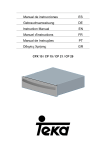Download Samsung NL20J7100WB Warming Drawer Oven User Manual(User manual)
Transcript
Model: NL20F7100WB EN Warming Drawer - Instruction Manual DE Wärmeschublade - Bedienungsanleitung FR Chauffe-vaisselle - Manuel d'instructions PL Szuflada do podgrzewania naczyń - Instrukcja obsługi EN Contents Safety Instructions ............................................................................................................................. 2 Installation instructions ..................................................................................................................... 5 Before installation ............................................................................................................................. 5 Installation ........................................................................................................................................ 5 Electrical Connection ........................................................................................................................ 5 Appliance Description ........................................................................................................................ 6 Main Components ............................................................................................................................ 6 How the warming drawer works ........................................................................................................ 6 Use ....................................................................................................................................................... 7 Before using for the first time ............................................................................................................ 7 Control Panel .................................................................................................................................... 7 Using the warming drawer ................................................................................................................ 7 Selecting temperature ...................................................................................................................... 7 Cleaning and Maintenance................................................................................................................. 9 Appliance front and control panel ..................................................................................................... 9 Interior of the warming drawer .......................................................................................................... 9 Mat with non-slip surface .................................................................................................................. 9 What should I do if the warming drawer doesn’t work? ................................................................ 10 Installation ......................................................................................................................................... 46 Combination possibilities ................................................................................................................ 46 We ask you to read the instructions in this booklet very carefully as this will allow you to get the best results from using your warming drawer. KEEP THE DOCUMENTATION OF THIS PRODUCT FOR FUTURE REFERENCE. 1 EN Safety Instructions • Warning! Before connecting the appliance compare the power data (voltage and frequency) indicated on the characteristics plate with those of the power supply in question. If these data do not match there may be problems. In case of doubt, contact an electrician. • Warning! If the electrical wire plug is removed, the appliance must be installed and connected by a technician. Contact a qualified electrician who knows and respects current safety standards. The manufacturer cannot be held responsible for damage resulting from fitting or connecting errors. • Warning! The electrical safety of the appliance can only be guaranteed if it is earthed. The manufacturer cannot be held responsible for damage resulting from the absence of or defects in the installation’s protection system (e.g. electrical shock). • Warning! Only use the appliance once it has been fitted into its built-in position. Only in this manner can it be guaranteed that users cannot access the electrical components. • Warning! Never open up the appliance’s frame. Possible contacts with electrical conducting parts or changes to electrical or mechanical components may represent a danger to users’ safety and prejudice the correct working of the appliance. • Warning! Repairs and maintenance, especially of parts carrying electrical current, must only be done by technicians authorised by the manufacturer. The manufacturer and retailers do not accept responsibility for any damaged caused to people, animals or property as a result of repairs and maintenance carried out by nonauthorised personnel. • Warning! Repairs undertaken during the guarantee period must only be done by technicians authorised by the manufacturer. If this is not the case then any damage resulting from the repair in question is excluded from the guarantee. • Warning! The appliance must be disconnected from the electrical current when installation and repair work is being done. To disconnect the appliance from the current, one of the following conditions must apply: - The switchboard fuses / circuit breakers must be disconnected. - The plug should be removed from the socket. To remove the plug from the socket do not pull on the electric cable but rather pull out the plug itself directly. 2 EN Safety Instructions • This appliance complies with current safety standards. Improper use of the appliance may put the user at risk. • Read the operating instructions carefully before using the appliance for the first time. In this way you will avoid the risk of injuring yourself or damaging the appliance. • The warming drawer is solely for domestic use! • Use the warming drawer solely for warming crockery. Any other type of use is unacceptable and may be dangerous. The manufacturer does not accept responsibility for breakdowns or faults arising from improper or erroneous use of the appliance. • Do not use the appliance to heat up or to cook food or drinks. • Depending on the temperature selected and the operating time, the temperature inside the appliance may reach 80 ºC. To take crockery out of the warming drawer protect your hands by using oven gloves or an oven cloth. 3 • Take special care with children and do not allow them to play close to the appliance. If the appliance is inadvertently switched on it will heat up and may cause serious burns. • WARNING: The appliance and its accessible parts become hot during use. Care should be taken to avoid touching heating elements. Children less than 8 years of age shall be kept away unless continuously supervised. • This appliance can be used by children aged from 8 years and above and persons with reduced physical, sensory or mental capabilities or lack of experience and knowledge if they have been given supervision or instruction concerning use of the appliance in a safe way and understand the hazards involved. Children shall not play with the appliance. Cleaning and user maintenance shall not be made by children without supervision. EN Safety Instructions • Do not sit or hang on the drawer. The telescopic runners will be damaged. The maximum load capacity of the drawer is 25 kg. • Do not store synthetic containers or easily inflammable objects inside the drawer warmer. When you switch on the appliance such containers and objects may melt or catch fire. Fire danger. • Do not use the appliance to heat up the air temperature in the kitchen. The high temperatures reached may cause easily inflammable objects close to the appliance to catch fire. • Do not use high pressure or steam jet cleaning devices. The steam may affect electrical components and cause a short circuit. The steam pressure may also cause damage to the appliance’s surface and components in the long term. • When you stop using the appliance at the end of its working life, disconnect it from the power supply and render the electrical cable unusable so that the appliance is not a danger if, for example, children use it for playing. 4 EN Installation instructions Before installation Check that the input voltage indicated on the characteristics plate is the same as the voltage of the power outlet you are going to use. Open the drawer and take out all the accessories and remove the packing material. 2. Check that the warming drawer frame is properly levelled and is sitting evenly on the shelf. 3. Open the drawer and fix the warming drawer to the sides of the unit using the two screws provided. Attention! The front surface of the crockery heater may be wrapped in a protective film. Before using the warming drawer for the first time, remove this film carefully. Make sure that the warming drawer is not damaged in any way. Check that the drawer opens and closes correctly. If you find any damage, contact the Technical Assistance Service. Attention: the power socket should be easily accessible after the warming drawer has been installed. The warming drawer should only be built-in in combination with those appliances indicated by the manufacturer. If it is fitted in combination with other appliances, the guarantee is no longer valid since it is impossible to guarantee that the warming drawer will work correctly. Installation To build-in the warming drawer in combination with another appliance there must be a fixed, interim shelf in the housing unit to support the weight of both appliances. The appliance to be combined with the warming drawer will be placed directly on the latter without any need to have a separating shelf. To build-in the appliance which is combined with the warming drawer, follow the instructions set out in the respective instructions and fitting booklet. The relevant installation dimensions are indicated in mm in the diagrams shown at the end of this booklet. Proceed as follows: 1. Place the warming drawer on the shelf and slide it towards the interior of the niche in such a way that it is centred and completely lined up with the front of the unit. 5 Electrical Connection The warming drawer is equipped with a power cable and plug for single phase current. We advise that the plug is connected to a socket that is easily accessible after installation. If the warming drawer is to be installed on a permanent basis it should be installed by a qualified technician. In such a case, the appliance should be connected to a circuit with an all-pole circuit breaker with a minimum separation of 3 mm between contacts. The data necessary for the electrical connection are described on the warming drawer characteristics plate and these must be compatible with those of the power outlet you are going to use. WARNING: THE WARMING DRAWER MUST BE CONNECTED TO EARTH. The manufacturer and retailers do not accept responsibility for any damage that may be caused to people, animals or property if these installation instructions are not observed. EN Appliance Description Main Components 1. Temperature selector (thermostat) 3. Operating light 2. On/Off switch (lights up) 4. Anti-slip mat How the warming drawer works This appliance is equipped with a warm air circulation system. A fan distributes the heat generated by an electrical heating element throughout the interior of the appliance. The thermostat allows the user to define and control the temperature wanted for the crockery. The circulating hot air that is generated heats up the crockery quickly and evenly. A metal grille protects both the heating element and the fan. The base of the drawer is fitted with a non-slip mat to prevent plates and dishes sliding around when the drawer is opened and closed. 6 EN Use Before using for the first time Before using the appliance for the first time you should clean the interior and the exterior, following the cleaning instructions given in the section “Cleaning and Maintenance”. Then heat the warming drawer for at least 2 hours. For this, turn the temperature control to the maximum position (see section ‘Selecting temperature”). Make sure the kitchen is well-ventilated when you are doing this. The appliance’s parts are protected by a special product. For this reason, during the first heating an odour will be released. Both the odour and any smoke that may form will disappear after a short time and neither signifies that there is anything wrong with the connection or the appliance. Control Panel • Switch on the appliance by pressing the switch, which will light up. • Close the drawer. Be careful not to use too much force when closing the drawer since it may open up again. Before taking out the warm crockery you must switch off the warming drawer by pressing the switch again. Selecting temperature By turning the thermostat control you can select temperatures between 30 and 85 °C. Do not force the thermostat control to the left of the “0” position or to the right of the maximum position since this may damage the appliance. As soon as the temperature selected is reached, the heating is turned off. When the temperature drops to a value below that selected, the heating is turned back on. The temperature scale is not marked with absolute temperatures in ºC but instead has symbols which correspond to the optimum temperatures for groups of crockery: Symbol The control panel has a temperature selector and the on/off switch. The control panel is only visible when the drawer is open. When the drawer is closed you can check whether the warming drawer is switched on by looking through the viewing port on the front of the appliance. Using the warming drawer To use the warming drawer, proceed as follows: • Push the center of the front face to open the warming drawer. • Put the crockery in the drawer. • Select the temperature you want by turning the thermostat control to the desired position. 7 ºC Function 30ºC Defrosting 40ºC50ºC Proving dough Cups / glasses warming 60ºC70ºC Crockery warming 80ºC Low temperature cooking Keep food warm Food Warming EN Use Heating times Load capacity Various factors affect heating times: • Material and thickness of the crockery • Load quantity • How the crockery is arranged • Temperature setting Load capacity depends on the size of the items of crockery. The warming drawer can be loaded with a maximum of 25 kg. It is therefore not possible to give any precise heating times. However, as a guide, the following times are given and for uniform for the thermostat setting heating of the crockery: Below we give you some crockery arrangements as examples: • Crockery for 6 people: - 6 dinner plates Ø 28 cm - 6 soup bowls Ø 10cm - 1 dish Ø 22 cm - 1 dish Ø 19 cm Load Time (min) - 1 dish Ø 17 cm Crockery for 6 people 30 – 35 - 2 large plates Ø 36 cm As you use the warming drawer more and more you will learn the best settings for your crockery. or one of the following • 20 dinner plates Ø 28 cm • 36 soup bowls Ø 22 cm • 30 soup bowls Ø 10cm • 10 dinner plates Ø 28cm • 10 soup bowls Ø 22 cm • 10 pizza plates Ø 36 cm • 80 expresso cups • 40 cappuccino cups • 30 glasses • 18 soup bowls Ø 22 cm; 2 soup tureens 21 cm x 18 cm • Etc. 8 EN Cleaning and Maintenance Cleaning is the only maintenance action that is required normally. Warning! Cleaning must be done with the warming drawer disconnected from the electrical power supply. Remove the plug from the power socket or disconnect the warming drawer power supply circuit. Do not use aggressive or abrasive cleaning products, abrasive sponges or pointed objects since stains or abrasion marks may appear. Do not use high pressure or steam jet cleaning appliances. Appliance front and control panel The warming drawer can be cleaned using just a damp cloth. If it is very dirty, add a few drops of washing-up liquid to the washing water. Wipe the surfaces dry using a dry cloth. For stainless steel fronted warming drawer, special products for treatment of stainless steel surfaces can be used. These products prevent the surfaces becoming dirty again for some time. Apply a thin layer of such a product on the surface using a soft cloth. On aluminium fronted warming drawer use a gentle glass cleaning product and a soft cloth that does not release fluff. Wipe horizontally without pressing on the surface since aluminium is sensitive to scratches and cuts. 9 Interior of the warming drawer Clean the inside of the warming drawer regularly using a damp cloth. If it is very dirty add a few drops of washing-up liquid to the washing water. Wipe the surfaces dry using a dry cloth. Avoid water entering through the air circulation opening. Only use the warming drawer again when it is completely dry. Mat with non-slip surface The non-slip surface mat can be removed to facilitate cleaning of the drawer. The mat can be cleaned by hand using hot water with a few drops of washing-up liquid. Dry thoroughly. The non-slip mat should only be replaced when it is completely dry. EN What should I do if the warming drawer doesn’t work? WARNING! Any type of repair must only be done by a specialised technician. Any repair done by a person not authorised by the manufacturer is dangerous. Before contacting Technical Assistance, check on the following: • The crockery doesn’t heat up enough. Check whether: - The appliance has been switched on. - The appropriate temperature has been selected. - The air circulation orifices are covered by the crockery. - The crockery was left to heat up for sufficient time. Heating time depends on several factors, such as, for example: - Crockery material type and thickness. - Quantity of crockery. - How the crockery is arranged. • The crockery doesn’t heat up at all. Check whether: - You can hear the noise of a fan. If the fan is operating then the heating element is broken; if the fan is not operating then the fan is broken. - The switchboard fuses / circuit breakers have fused / tripped out. • The crockery is heating up too much. - The temperature selector is broken. • The on/off switch does not light up. - The switch’s pilot light has blown. • There is some noise when the drawer is opened and closed: - This is normal and comes from the latching mechanism. After checking the points and if non of them matches your problem, please contact our Technical Assistance. 10 EN appliances should not be put into the normal systems for disposal of solid urban waste. Environmental protection Disposal of the packaging The packaging bears the Green Point mark. Dispose of all the packaging materials such as cardboard, expanded polystyrene and plastic wrapping in the appropriate bins. In this way you can be sure that the packaging materials will be re-used. Please keep all packaging materials away from small children as there is a choking / suffocation risk. Disposal of equipment no longer used According to European Directive 2002/96/EC on the management of waste electrical and electronic equipment (WEEE), home electrical Outdated appliances should be collected separately to optimise component material recovery and re-cycling rates and to prevent potential harm to human health and the environment. The symbol of a rubbish container superimposed by a diagonal cross should be put on all such products to remind people of their obligation to have such items collected separately. Consumers should contact their local authorities or point of sale and request information on the appropriate places to leave their old home electrical appliances. Before disposing of your appliance, render it nonusable by pulling out the power cable, cutting this and disposing of it. Technical Data SAMSUNG strives to improve its products at all times. Both the design specifications and these user instructions are thus subject to change without notice. Model NL20F7100WB Power source 220-240 V / 50-60 Hz Power consumption Maximum Power 420W Dimensions (WxDxH) Outside 595x576x140 Drawer Cavity 500x470x100 Volume 25,2 ltr Weight Net 11 16,3 kg DE Inhaltsverzeichnis Sicherheitshinweise ......................................................................................................................... 13 Sachgemäßer Gebrauch................................................................................................................... 15 Installationsanleitung ....................................................................................................................... 16 Vor der Installation.......................................................................................................................... 16 Einbau ............................................................................................................................................ 16 Elektroanschluss ............................................................................................................................ 16 Gerätebeschreibung ......................................................................................................................... 17 Hauptkomponenten ........................................................................................................................ 17 Vorinformationen ............................................................................................................................ 17 Bedienung ......................................................................................................................................... 18 Vor dem ersten Gebrauch .............................................................................................................. 18 Bedienelemente.............................................................................................................................. 18 Bedienprinzip .................................................................................................................................. 18 Temperatur wählen......................................................................................................................... 18 Aufheizzeiten .................................................................................................................................. 19 Fassungsvermögen ........................................................................................................................ 19 Reinigung und Pflege ....................................................................................................................... 20 Stirnseite und Bedienblende ........................................................................................................... 20 Innenraum ...................................................................................................................................... 20 Antirutschauflage ............................................................................................................................ 20 Was ist im Falle einer Funktionsstörung zu tun? .......................................................................... 21 Einbau ................................................................................................................................................ 46 Kombinationsmöglichkeiten ............................................................................................................ 46 Wir bitten Sie, die in diesem Buch enthaltenen Anweisungen aufmerksam durchzulesen, die Ihnen ermöglichen werden, bei der Nutzung Ihrer Wärmeschublade bessere Ergebnisse zu erzielen. BEWAHREN SIE DIE DOKUMENTATION DIESES GERÄTES AUF, UM KÜNFTIG IN IHR NACHSCHLAGEN ZU KÖNNEN. 12 DE Sicherheitshinweise • Achtung! Vergleichen Sie vor dem Anschließen des Gerätes die Anschlussdaten (Spannung und Frequenz) auf dem Typenschild mit denen des Elektronetzes. Diese Daten müssen unbedingt übereinstimmen, damit keine Schäden am Gerät auftreten. Im Zweifelsfall fragen Sie Ihren Elektroinstallateur. • Achtung! Wird der Stecker von der Netzanschlussleitung entfernt, muss das Gerät von einer Elektrofachkraft eingebaut und angeschlossen werden. Beauftragen Sie bitte eine Elektrofachkraft, die die landesüblichen Vorschriften und die Zusatzvorschriften der örtlichen Elektroversorgungsunternehmen genau kennt und sorgfältig einhält. Der Hersteller kann nicht für Schäden verantwortlich gemacht werden, die durch Fehler beim Einbau oder Anschluss verursacht werden. • Achtung! Die elektrische Sicherheit des Gerätes ist nur dann gewährleistet, wenn es an ein vorschriftsmäßig installiertes Schutzleitersystem angeschlossen wird. Der Hersteller kann nicht für Schäden verantwortlich gemacht werden, die durch eine fehlende 13 oder unterbrochene Schutzleiterverbindung verursacht werden (z. B. elektrischer Schlag). • Achtung! Benutzen Sie das Gerät nur im eingebauten Zustand. Nur so ist sichergestellt, dass Sie nicht mit Strom führenden Teilen in Berührung kommen. • WARNUNG: Dieses Gerät kann von Kindern ab 8 Jahren und Personen mit verminderten körperlichen, sensorischen oder geistigen Fähigkeiten oder einem Mangel an Erfahrung und Wissen bedient werden, wenn sie unter Aufsicht stehen oder eine Unterweisung zum sicheren Umgang mit dem Gerät erhalten haben und die damit verbundenen Gefahren ver-stehen. Kinder dürfen nicht mit dem Gerät spielen. Reinigung und Wartung durch den Benutzer dürfen von Kindern nur unter Aufsicht durchgeführt werden. DE Sicherheitshinweise • Achtung! Öffnen Sie auf keinen Fall das Gehäuse des Gerätes. Eventuelles Berühren spannungsführender Teile sowie Verändern des elektrischen und mechanischen Aufbaus gefährden Sie und führen möglicherweise zu Funktionsstörungen des Gerätes. • Achtung! Installations- und Wartungsarbeiten sowie Reparaturen dürfen nur qualifizierte Fachleute durchführen. Durch unsachgemäße Installations- und Wartungsarbeiten oder Reparaturen können erhebliche Gefahren für den Benutzer entstehen, für die der Hersteller nicht haftet. • Achtung! Eine Reparatur des Gerätes während der Garantiezeit darf nur von einem vom Hersteller autorisierten Kundendienst vorgenommen werden, sonst besteht bei nachfolgenden Schäden kein Garantieanspruch mehr. • Achtung! Bei Installations- und Reparaturarbeiten muss das Gerät vom Netz getrennt sein. Das Gerät ist nur dann elektrisch vom Netz getrennt, wenn eine der folgenden Bedingungen erfüllt ist: – die Sicherungen der Hausinstallation ausgeschaltet sind, – die Netzanschlussleitung vom Elektronetz getrennt ist. Ziehen Sie bei Geräten mit Netzstecker nicht an der Anschlussleitung, sondern am Stecker, um das Gerät vom Netz zu trennen. 14 DE Sachgemäßer Gebrauch • • • • • • • 15 Dieses Gerät entspricht den vorgeschriebenen Sicherheitsbestimmungen. Ein unsachgemäßer Gebrauch kann jedoch zu Schäden an Personen und Sachen führen. Lesen Sie vor dem ersten Benutzen aufmerksam die Gebrauchsanweisung. Dadurch schützen Sie sich selbst und vermeiden Schäden an Ihrem Gerät Benutzen Sie das Gerät ausschließlich zum Vorwärmen von Geschirr! Andere Anwendungsarten sind unzulässig und möglicherweise gefährlich. Der Hersteller haftet nicht für Schäden, die durch bestimmungswidrigen Gebrauch oder falsche Bedienung verursacht werden. Verwenden Sie das Gerät nicht zum Warmhalten, Aufwärmen oder Garen von Speisen oder Getränken. Die Feuchtigkeit der Speisen oder Getränke kann zur Korrosion des Gerätes führen. Das Gerät kann im Innenraum je nach gewählter Temperatur und Benutzungsdauer bis zu ca. 80 °C heiß werden. Verwenden Sie zum Herausnehmen des erwärmten Geschirrs bei Bedarf Topfhandschuhe. Beachten Sie, dass Kinderhaut erheblich empfindlicher auf hohe Temperaturen reagiert. Hindern Sie daher Kinder daran, mit dem Gerät zu spielen. Bei versehentlichem Einschalten erwärmt sich das Gerät, und es kann zu Verbrennungen kommen. • • • • • • Kinder dürfen das Gerät nur ohne Aufsicht benutzen, wenn Ihnen die Bedienung so erklärt wurde, dass sie das Gerät sicher bedienen können. Stellen oder setzen Sie sich nicht auf die geöffnete Geschirrschublade. Der Teleskopauszug wird beschädigt. Die Belastbarkeit der Geschirrschublade beträgt max. 25 kg Bewahren Sie keine Kunststoffbehälter oder brennbare Gegenstände im Gerät auf. Beim Einschalten können sie schmelzen oder sich entzünden. Brandgefahr! Benutzen Sie das Gerät nicht zum Beheizen von Räumen. Durch die Temperaturentwicklung können leicht entzündbare Gegenstände in der Nähe zu brennen beginnen. Verwenden Sie keinesfalls einen Dampfreiniger. Zum einen kann der Dampf an spannungsführende Teile gelangen und einen Kurzschluss auslösen. Zum anderen kann der Dampfdruck zu dauerhaften Beschädigungen von Oberflächen und Bauteilen führen, für die der Hersteller keinen Schadenersatz leistet Nicht mehr benutzte Geräte müssen vom Elektronetz getrennt und alle wegführenden elektrischen Leitungen entfernt werden, damit sie z. B. für spielende Kinder keine Gefahr darstellen. DE Installationsanleitung Vor der Installation Überprüfen Sie, dass die Versorgungsspannung, die auf dem Typenschild angegeben ist, mit Ihrer Netzspannung übereinstimmt. 3. Öffnen Sie die Schublade und befestigen Sie das Gerät mit den 2 mitgelieferten Schrauben an den Seitenwänden des Schrankes. Öffnen Sie die Schublade und entnehmen Sie alle Zubehörteile sowie das Verpackungsmaterial. Achtung! Die Vorderseite der Schublade kann mit einer Schutzfolie versehen sein. Ziehen Sie diese Folie vor der ersten Benutzung des Gerätes vorsichtig ab, indem Sie an deren Unterseite beginnen. Vergewissern Sie sich, dass die Wärmeschublade nicht beschädigt ist. Überprüfen Sie, ob die Schublade richtig schließt Benachrichtigen Sie den Kundendienst im Falle von vorhandenen Schäden. Achten Sie darauf, dass die Steckdose nach Einbau des Gerätes leicht zugänglich ist. Der Geschirrwärmer darf ausschließlich in Kombination mit den vom Hersteller angegeben Geräten eingebaut werden. Bei Kombination mit anderen Geräten erlischt der Garantieanspruch, da die Gewähr für einen ordnungsgemäßen Betrieb nicht mehr gegeben ist. Einbau Für den Einbau von Geschirrwärmer und Kombinationsgerät muss ein fest eingebauter Zwischenboden vorhanden sein, der die erforderliche Tragfähigkeit für beide Geräte gewährleistet. Das Kombinationsgerät wird ohne weiteren Zwischenboden direkt auf den eingebauten Geschirrwärmer gestellt. Beachten Sie für den Einbau des Kombinationsgerätes unbedingt die Informationen der jeweiligen Gebrauchs- bzw. Montageanweisung. Elektroanschluss Die Wärmeschublade ist mit einem Netzkabel und einem Stecker für Einphasenstrom ausgestattet. Es wird empfohlen, das Gerät über eine Steckdose an das Elektronetz anzuschließen. Dadurch wird der Kundendienst erleichtert. Im Falle eines Daueranschlusses ist das Gerät von einem qualifizierten Techniker zu installieren. In diesem Falle hat der Anschluss an einen Stromkreis mit einem Unterbrecher für sämtliche Pole, mit einem Mindestabstand von 3 mm zwischen den Kontakten, zu erfolgen. Die erforderlichen Anschlussdaten finden Sie auf dem Typenschild. Diese Angaben müssen mit denen des Netzes übereinstimmen. ACHTUNG: DIE WÄRMESCHUBLADE MUSS UNBEDINGT GEERDET WERDEN. Der Hersteller und die Wiederverkäufer lehnen jegliche Haftung für eventuelle Schäden ab, die Personen, Tieren oder Sachen zugefügt werden, falls die Nichtbeachtung der vorliegenden Installationsanleitung festgestellt wird. Die wichtigen Masse für den Einbau werden in “mm” auf den letzten Seiten dargestellt. Wie folgt vorgehen: 1. Stellen Sie das Gerät bis zur Schwadenleiste in den Umbauschrank und richten Sie es aus. 2. Achten Sie darauf, dass das Gehäuse des Gerätes rechtwinklig ausgerichtet wird. 16 DE Gerätebeschreibung Hauptkomponenten 1. – Bedienblende 2. – Temperaturknebel 3. – Gerätefront 4. – Antirutschauflage Vorinformationen Dieses Gerät verfügt über ein Heißluftsystem. Ein Gebläse verteilt die Wärme des Heizkörpers optimal in der Schublade. Das Thermostat ermöglicht die Bestimmung und Überwachung der gewünschten Geschirrtemperatur. Durch die entstehende Luftzirkulation wird das Geschirr gleichmäßig und schnell erwärmt. 17 Ein Schutzgitter verhindert die Berührung mit Heizkörper und Gebläse. Der Boden der Geschirrschublade ist mit einer Antirutschauflage ausgelegt, die das Verrutschen des Geschirrs beim Öffnen und Schließen der Schublade verhindert. DE Bedienung Vor dem ersten Gebrauch Vor dem ersten Benutzen sollten Sie wie folgt vorgehen: Wischen Sie Ihr Gerät mit einem feuchten Tuch ab und trocken Sie es anschließend. Siehe Kapitel „Reinigung und Pflege“. Heizen Sie die leere Schublade mindestens 2 Stunden lang auf. Stellen Sie dazu den Temperaturknebel auf Maximum (siehe Kapitel "Temperatur wählen"). Sorgen Sie dabei für eine gute Belüftung der Küche. Die Bauteile sind mit einem Pflegemittel geschützt. Deshalb kommt es beim ersten Aufheizen vorübergehend zur Geruchsbildung. Die Geruchsbildung und eventuell auftretender Dunst vergehen nach kurzer Zeit und weisen nicht auf einen Falschanschluss oder Gerätedefekt hin. Bedienelemente • Schalten Sie das Gerät durch drücken des Knopfes ein. Der Knopf leuchtet auf. • Schließen Sie die Schublade. Beachten Sie, dass sich die Schublade wieder öffnen kann, wenn sie mit übermäßigem Schwung geschlossen wird. Schalten Sie das Gerät aus, bevor Sie das erwärmte Geschirr entnehmen. Temperatur wählen Der Temperaturknebel ermöglicht die stufenlose Einstellung der Temperatur zwischen ca. 30 und 80 °C. Den Temperaturknebel nur linksherum bis zur Position “0“drehen oder nach rechts bis zum Anschlag, den sonst wird der Knebel zerstört. Ist die gewählte Temperatur erreicht, schaltet sich die Heizung ab. Sobald die Temperatur unter den eingestellten Wert sinkt, schaltet sich die Heizung wieder ein. Auf der Temperaturskala sind keine absoluten Temperaturwerte in °C markiert, sondern Symbole, die die optimale Temperatur für die jeweilige Geschirrgruppe darstellen: Symbol Die Bedienelemente bestehen aus dem Temperaturknebel und dem Ein-/Aus- Schalter. Sie sind nur sichtbar, wenn die Geschirrschublade geöffnet ist. Bei geschlossener Schublade kann man durch das Kontrollfeld in der Gerätefront sehen, ob das Gerät eingeschaltet ist. ºC Funktion 30ºC Antauen 40ºC50ºC Teig gehen lassen Tassen/Gläser vorwärmen 60ºC-70ºC Geschirr vorwärmen 80ºC Speisen warm halten Speisen Erhitzen Bedienprinzip Um die Wärmeschublade zu verwenden verfahren wie folgt: • Drücken Sie die Front der Wärmeschublade um diese zu öffnen. • Stellen Sie das Geschirr in die Schublade. • Um die Temperatur zu wählen, bitte drehen Sie denn Schalter auf die gewünschte Position.. 18 DE Bedienung Fassungsvermögen Aufheizzeiten Unterschiedliche Faktoren beeinflussen Aufheizzeit: • Material und Dicke des Geschirrs • Beladungsmenge • Beladungsanordnung • Temperatureinstellung die Das Fassungsvermögen ist abhängig von den Geschirrmaßen; die Schublade darf mit maximal 25 kg belastet werden. Die folgenden Bestückungsbeispiele Anhaltspunkte: • Menügeschirr für 6 Personen: - 6 Teller Ø 28 cm Absolute Angaben sind daher nicht möglich. - 6 Suppentassen Ø 10cm und um Bei der Einstellung auf der Position eine gleichmäßige Erwärmung zu erreichen können folgende Werte als Anhaltspunkte genannt werden: - 1 Schüssel Ø 22 cm Geschirr Menügeschirr für 6 Personen Zeit (Minuten) 30 – 35 Bitte ermitteln Sie im praktischen Gebrauch die optimalen Einstellungen für Ihren Haushalt. 19 sind - 1 Schüssel Ø 19 cm - 1 Schüssel Ø 17 cm - 2 Teller Ø 36 cm oder • 20 Teller Ø 28 cm • 36 Suppenteller Ø 22 cm • 30 Suppentassen Ø 10cm • 10 Teller Ø 28cm • 10 Suppenteller Ø 22 cm • 10 Pizzateller Ø 36 cm • 80 Espressotassen • 40 Cappuccinotassen • 30 Gläser • 18 Suppenteller Ø 22 cm; 2 Suppenterrinen 21 cm x 18 cm • usw. DE Reinigung und Pflege Die Reinigung stellt die einzige, normalerweise erforderliche Wartung dar. Achtung! Die Reinigung muss an dem von der Stromversorgung getrennten Gerät durchgeführt werden. Ziehen Sie den Stecker aus der Steckdose oder schalten Sie den Stromversorgungskreis des Gerätes ab. Benutzen Sie keine aggressiven Reinigungsoder Scheuermittel, keine kratzenden Scheuertücher noch spitze Gegenstände, denn es können Flecken entstehen. Stirnseite und Bedienblende Es reicht, das Gerät mit einem feuchten Lappen zu reinigen. Geben Sie, falls es sehr verschmutzt sein sollte, einige Tropfen Geschirrspülmittel ins Waschwasser. Wischen Sie danach das Gerät mit einem trockenen Lappen ab. Für Wärmeschubladen mit Edelstahlvorderseite können Spezialmittel für Edelstahloberflächen verwendet werden. Diese Mittel vermeiden dass die Oberflächen schnell wieder schmutzig werden. Tragen Sie das Mittel mit einem weichen Tuch flächig und sparsam auf. Innenraum Reinigen Sie nach jeder Nutzung die Innenwände mit einem feuchten Lappen. Geben Sie, falls sie sehr verschmutzt sein sollten, einige Tropfen Geschirrspülmittel ins Waschwasser. Wischen Sie danach die Oberflächen mit einem trockenen Lappen ab. Verhindern Sie das Eindringen von Wasser in die Belüftungslöcher. Nutzen Sie die Wärmeschublade nur nachdem sie trocken ist. Antirutschauflage Die Antirutschauflage kann zur Reinigung des Schubladenbodens herausgenommen werden. Die Auflage reinigen Sie am besten von Hand mit warmem Wasser und einem milden Spülmittel. Trocknen Sie sie im Anschluss gut ab. Legen Sie die Antirutschauflage erst wieder in die Schublade, wenn sie ganz trocken ist. Benutzen Sie bei Wärmeschubladen mit einer Aluminiumvorderseite ein mildes Glasreinigungsmittel und einen weichen, fusselfreien Lappen. Wischen Sie diese in horizontaler Richtung ab, ohne Druck auf die Oberfläche auszuüben. 20 DE Was ist im Falle einer Funktionsstörung zu tun? ACHTUNG! Jegliche Art von Reparatur darf nur von spezialisierten Fachleuten ausgeführt werden. Jeder Eingriff, der durch nicht vom Hersteller autorisierte Personen vorgenommen wird, ist gefährlich. Folgende Probleme können behoben werden, ohne den Kundendienst zu benachrichtigen: Das Geschirr erwärmt nicht ausreichend? Prüfen Sie, ob: • – das Gerät eingeschaltet ist. – die richtige Temperatureinstellung gewählt wurde. – die Warmluft-Austrittsöffnungen durch große Platten oder Schüsseln verdeckt sind. – das Geschirr lange genug erwärmt wurde. Unterschiedliche Faktoren beeinflussen die Aufheizzeit, zum Beispiel: – Material und Dicke des Geschirrs – Beladungsmenge – Beladungsanordnung – Temperatureinstellung 21 • Das Geschirr erwärmt nicht? Prüfen Sie, ob: – Sie ein Gebläsegeräusch hören. Falls das Gebläse läuft, ist der Heizkörper defekt. Falls das Gebläse nicht läuft ist das Gebläse defekt. – die Sicherung der Hausinstallation ausgelöst hat. • Das Geschirr wird zu heiß? – Der Temperaturregler ist defekt. • Beim Einschalten des Gerätes leuchtet der Ein-/Aus-Schalter nicht? – Die Kontrollleuchte des Schalters ist defekt. DE Hinweise zum Umweltschutz Hinweise zum Umweltschutz Entsorgung der Verpackung Die Verpackung ist mit einem Grünen Punkt gekennzeichnet. Benutzen Sie geeignete Behältnisse, um alle Verpackungsmaterialien, wie Pappe, Styropor und Folien, zu entsorgen. Auf diese Weise wird die Wiederverwertung der Verpackungsmaterialien gewährleistet. Entsorgung von stillgelegten Geräten Die europäische Richtlinie 2002/96/EG über Elektro- und Elektronik-Altgeräte (WEEE) sieht vor, dass die elektrischen Haushaltgeräte nicht im normalen Abfallfluss des festen Stadtmülls entsorgt werden dürfen. Die außer Betrieb gesetzten Geräte müssen getrennt abgeholt werden, um den Anteil der Rückgewinnung und Wiederverwendung der Werkstoffe, aus denen sie bestehen, zu optimieren und um potentielle Schäden für die Gesundheit der Menschen und die Umwelt zu vermeiden. Das Symbol, welches aus einem mit einem Kreuz durchgestrichenen Müllcontainer besteht, ist auf sämtlichen Erzeugnissen anzubringen, um so an die Verpflichtung der separaten Abholung zu erinnern. Die Verbraucher haben sich mit den lokalen Behörden bzw. den Verkaufsstellen in Verbindung zu setzen, um Informationen über den Ort einzuholen, der zur Lagerung der alten elektrischen Haushaltsgeräte geeignet ist. Machen Sie Ihr Gerät unbrauchbar, bevor Sie es entsorgen. Ziehen Sie das Netzkabel heraus, schneiden Sie es ab und entsorgen Sie es. Caractéristiques techniques Modell NL20F7100WB Betriebsspannung 220-240 V / 50-60 Hz Stromverbrauch Maximale Leistung 420W Außen Abmessung 595x576x140 Hohlraum - Schublade 500x470x100 Volumen 25,2 ltr Netto Gewicht 16,3 kg 22 FR Sommaire Indications de sécurité ..................................................................................................................... 24 Précautions pendant l'utilisation..................................................................................................... 25 Instructions d'installation ................................................................................................................ 27 Avant l'installation ........................................................................................................................... 27 Installation ...................................................................................................................................... 27 Description de l'appareil .................................................................................................................. 28 Composants principaux .................................................................................................................. 28 Principe de fonctionnement ............................................................................................................ 28 Utilisation .......................................................................................................................................... 29 Avant la première utilisation............................................................................................................ 29 Tableau de commandes ................................................................................................................. 29 Principe d'utilisation ........................................................................................................................ 29 Nettoyage et entretien ...................................................................................................................... 31 Partie avant de l'appareil et tableau de commandes ...................................................................... 31 Intérieur du tiroir chauffant .............................................................................................................. 31 Revêtement antidérapant ............................................................................................................... 31 Que faire en cas de mauvais fonctionnement?.............................................................................. 32 Installation ......................................................................................................................................... 46 Possibilités de combinaison............................................................................................................ 46 Nous vous demandons une lecture attentive des instructions de ce manuel. Vous pourrez ainsi utiliser votre tiroir chauffant en obtenant les meilleurs résultats. CONSERVEZ TOUTE LA DOCUMENTATION DE CE PRODUIT POUR LA CONSULTER ULTÉRIEUREMENT. 23 FR Indications de sécurité • Attention ! Avant de brancher l'appareil, comparez-en les données (tension et fréquence) indiquées sur la plaque des caractéristiques avec celles de votre réseau électrique. Elles doivent correspondre, pour éviter tout problème. En cas de doute, appelez un électricien. • Attention ! Si la prise de l'appareil doit être changée, l'installation et le branchement doivent être effectués par un technicien. Adressez-vous à un électricien attitré qui respecte les normes de sécurité. La responsabilité du fabricant n'est pas engagée pour des dommages provenant d'une erreur de montage ou de branchement. • Attention ! La sécurité électrique de l'appareil n'est assurée que s'il est relié à la terre. La responsabilité du fabricant n'est pas engagée pour des dommages provenant d'un manque ou d'un défaut du système de protection de l'installation (choc électrique par exemple). • Attention ! Ne mettez l'appareil en marche qu'une fois celui-ci dûment encastré, car c'est la seule façon d'interdire l'accès aux composants électriques. • Attention ! N'ouvrez jamais la structure de l'appareil. D'éventuels contacts avec les pièces conductrices ou modifications des composants électriques ou mécaniques peuvent constituer un danger pour la sécurité de l'utilisateur et perturber le bon fonctionnement de l'appareil. • Attention ! Les réparations et entretiens, tout particulièrement sur les pièces sous tension, ne peuvent être effectués que par des techniciens agréés par le fabricant. Le fabricant et les revendeurs déclinent toute responsabilité pour d'éventuels dommages, causés aux personnes, aux animaux ou aux biens, qui découlent de réparations ou entretiens effectués par des personnes non autorisées. • Attention ! Les réparations au cours de la période de garantie ne doivent être exécutées que par des techniciens agréés par le fabricant. Dans le cas contraire, tout dommage provenant de ces réparations est exclu de la garantie. • Attention ! L'appareil doit être débranché du réseau électrique quand sont effectués les travaux d'installation et de réparation. Pour que l'appareil soit débranché, vous devez constater l'une des conditions suivantes : - Les fusibles/disjoncteur du tableau électrique sont débranchés. - L'appareil est débranché de la prise murale, ce qui doit être fait en tirant sur la prise de l'appareil et non sur le câble électrique. 24 FR Précautions pendant l'utilisation • Votre appareil est aux normes de sécurité en vigueur. Une utilisation inadéquate peut constituer un danger pour l'utilisateur. • Avant la première utilisation, lisez avec attention les instructions d'utilisation. Vous vous protégez et évitez ainsi tout problème. • Le tiroir chauffant est exclusivement destiné à un usage domestique ! • Utilisez le tiroir chauffant exclusivement pour chauffer de la vaisselle. Toute autre utilisation est inadmissible, potentiellement dangereuse, et dégage le fabricant de toute responsabilité pour tout dommage qui en découlerait. • N'utilisez pas votre appareil pour cuisiner ou réchauffer des aliments ou des boissons. • Selon la température et le temps de fonctionnement sélectionnés, la température à l'intérieur de l'appareil peut monter jusqu'à 80 ºC. Utilisez des gants de cuisine pour vous 25 protéger les mains quand vous retirez la vaisselle de l'intérieur du tiroir chauffant. • Faites particulièrement attention aux enfants. Ne les laissez pas s'approcher de l'appareil. S'il est mis en marche par inadvertance, il chauffera et peut provoquer des brûlures graves. • Cet appareil n’est pas indiqué pour l’utilisation de la part de personnes (y compris les enfants) ayant des capacités physiques, sensorielles ou mentales réduites. Les utilisateurs n’ayant pas l’expérience, une connaissance suffisante de l’appareil ou n’ayant pas reçu les instructions relatives à l’appareil, devront faire l’objet d’un contrôle de supervision de la part d’une personne responsable de leur sécurité. Il est nécessaire de surveiller les enfants pour empêcher qu’ils ne jouent avec l’appareil. FR Précautions pendant l'utilisation • Le tiroir peut supporter un poids maximum de 25 kg. Prenez garde de ne pas le surcharger, cela endommagerait les rails télescopiques. • Les récipients et objets synthétiques ou qui prennent facilement feu ne doivent pas être rangés dans le tiroir chauffant. Si l'appareil est mis en marche, ils peuvent fondre ou brûler. Danger d'incendie. • N'utilisez pas votre appareil comme chauffage de maison. Les hautes températures peuvent mettre le feu à des objets facilement inflammables situés près de l'appareil. • N'utilisez pas d'appareils de nettoyage à haute pression ou qui projettent de la vapeur. La vapeur peut atteindre les composants électriques et provoquer un courtcircuit. La pression de la vapeur peut aussi endommager durablement la surface de l'appareil et ses composants. • Quand vous cessez définitivement d'utiliser l'appareil, à la fin de sa vie utile, débranchez-le du réseau et éliminez le câble électrique pour éviter le danger que les enfants s'en servent pour s'amuser. 26 FR Instructions d'installation Avant l'installation Vérifiez que la tension d'alimentation de l'appareil, indiquée sur la plaque des caractéristiques, correspond à celle de votre installation. Ouvrez le tiroir et retirez tous les accessoires ainsi que le matériel d'emballage. Attention ! Le devant du tiroir chauffant peut être enveloppé d'une pellicule de protection. Retirez soigneusement cette pellicule avant la première utilisation. Vérifiez que le tiroir chauffant n'est pas endommagé. Assurez-vous que le tiroir s'ouvre et se ferme correctement. En cas de détérioration, appelez le Service d'assistance technique. Attention : la prise de courant doit rester facilement accessible après l'installation du tiroir chauffant. Le tiroir chauffant ne peut être encastré et combiné qu'avec les appareils indiqués par le fabricant. La garantie n'est pas valable s'il est monté et combiné avec d'autres appareils, car il n'est alors pas possible de garantir un fonctionnement correct. Installation Pour encastrer le tiroir chauffant et le combiner avec un autre appareil, vous devez utiliser une étagère intermédiaire fixe, capable de supporter le poids des deux appareils. L'appareil combiné avec le tiroir chauffant devra être placé directement sur le tiroir chauffant. Une étagère de séparation n'est pas nécessaire. 27 Pour encastrer l'appareil combiné avec le tiroir chauffant, suivez les indications figurant dans le manuel d'instructions et de montage de cet appareil. Les dimensions à prendre en considération pour l'installation sont indiquées en millimètres dans les croquis présentés dans les dernières pages. Procédez de la façon suivante : 1. Placez le tiroir chauffant sur l'étagère et poussez-le vers le fond de façon à ce qu'il soit bien centré et bord à bord avec l'avant du meuble. 2. Assurez-vous que la structure du tiroir chauffant est bien à niveau et bien stable sur l'étagère. 3. Ouvrez le tiroir pour fixer le tiroir chauffant sur les côtés du meuble avec les deux vis fournies. FR Description de l'appareil Composants principaux 1. Sélecteur de température (thermostat) 3. Pilote de fonctionnement 2. Bouton marche/arrêt (voyant lumineux) 4. Revêtement antidérapant Principe de fonctionnement Votre appareil est équipé d'un système de circulation d'air chaud. Un ventilateur distribue la chaleur, générée par une résistance électrique, dans tout l'intérieur de l'appareil. Le thermostat permet de définir et de contrôler la température souhaitée pour la vaisselle. La circulation de l'air chaud fait que la vaisselle est chauffée rapidement et uniformément. La résistance ainsi que le ventilateur sont protégés par une grille métallique. La base du tiroir est équipée d'un revêtement antidérapant pour empêcher la vaisselle de glisser quand vous ouvrez ou fermez le tiroir. 28 FR Utilisation Avant la première utilisation Avant d'utiliser l'appareil pour la première fois, vous devez en laver l'intérieur et l'extérieur en suivant les indications sur le nettoyage figurant au chapitre « Nettoyage et entretien ». Ensuite, chauffez le tiroir chauffant pendant au moins 2 heures en tournant le sélecteur de température sur la position maximum (consultez le chapitre « Sélectionner la température »). Veillez à aérer correctement la cuisine. Les pièces de l'appareil sont protégées par un produit spécial qui peut éventuellement, lors de la première mise en marche, dégager une odeur et un peu de fumée qui disparaissent très vite. Ni l'une ni l'autre ne constituent une anomalie de fonctionnement de l'appareil. Tableau de commandes • Sélectionnez la température en tournant le thermostat sur la position désirée. • Mettez l'appareil en marche en appuyant sur l'interrupteur dont le voyant s'allume. • Fermez le tiroir. Prenez garde que le tiroir peut se rouvrir si vous le fermez trop fort. Avant de retirer la vaisselle chaude, vous devez éteindre le tiroir chauffant en appuyant de nouveau sur l'interrupteur. Sélectionner la température Vous pouvez sélectionner des températures entre 30 et 85 ºC en tournant le thermostat. Ne forcez pas le bouton du thermostat, ni vers la gauche de la position « 0 » ni vers la droite de la position maximum, car cela pourrait le détériorer. Dès que la température sélectionnée est atteinte, le chauffage s'éteint. Il se rallume automatiquement si la température redescend. Au lieu de températures absolues en ºC, des symboles sont indiqués. Ils correspondent à la température optimisée pour un groupe de vaisselle : Symbole ºC Function Le tableau de commandes n'est visible que lorsque le tiroir est ouvert. Il comporte un bouton sélecteur de température et l'interrupteur marche/arrêt. Lorsque le tiroir est fermé, le voyant lumineux situé sur l'avant de l'appareil indique si le tiroir chauffant est en marche. Principe d'utilisation Pour utiliser le tiroir chauffant, procédez de la façon suivante : • Appuyez sur le centre de la face avant pour ouvrir le tiroir chauffant • Placez la vaisselle dans le tiroir. 29 30ºC Décongélation 40ºC50ºC Prouver la pâte 60ºC70ºC Réchauffement Tasses / verres Réchauffement vaisselle Gardez les aliments chauds 80ºC Cuisson à basse température Réchauffement des aliments FR Utilisation Capacité de charge Temps de chauffage Le temps de chauffage dépend de plusieurs facteurs : • Matériel et épaisseur de la vaisselle • Quantité de charge • Disposition de la vaisselle • Température sélectionnée La capacité de charge dépend de la taille de la vaisselle. Le tiroir chauffant peut recevoir une charge maximum de 25 kg. Quelques exemples de rangement sont fournis ciaprès à titre indicatif : • Vaisselle de table pour 6 personnes : - 6 assiettes Ø 28 cm Il est dès lors impossible d'indiquer des temps de chauffage rigoureusement exacts. - 6 bols à soupe Ø 10cm Les temps ci-dessous sont donnés à titre indicatif pour le thermostat en position et pour obtenir un chauffage uniforme de la vaisselle : - 1 Récipient Ø 19 cm Charge Temps (mn) Vaisselle de table pour 6 pers. 30 – 35 La pratique vous aidera à sélectionner les temps appropriés à votre vaisselle. - 1 Récipient Ø 22 cm - 1 Récipient Ø 17 cm - 2 assiettes Ø 36 cm ou • 20 assiettes Ø 28 cm • 36 assiettes à soupe Ø 22 cm • 30 bols à soupe Ø 10cm • 10 assiettes Ø 28cm • 10 assiettes à soupe Ø 22 cm • 10 assiettes à pizza Ø 36 cm • 80 tasses à café • 40 tasses à cappuccino • 30 verres • 18 assiettes à soupe Ø 22 cm ; 2 terrines à soupe 21 cm x 18 cm • Etc. 30 FR Nettoyage et entretien Le nettoyage est l'unique entretien normalement nécessaire. Intérieur du tiroir chauffant Attention ! Le nettoyage doit être effectué quand le tiroir chauffant est débranché de l'alimentation électrique. Retirez la prise du mur ou débranchez le circuit d'alimentation du tiroir chauffant. Nettoyez régulièrement l'intérieur du tiroir chauffant avec un chiffon humide. S'il est très sale, ajoutez quelques gouttes de produit vaisselle dans l'eau de lavage. N'utilisez pas de produits de nettoyage agressifs ou abrasifs, ni frottoirs ni objets pointus qui peuvent provoquer des rayures. Évitez de faire entrer de l'eau dans les orifices par où circule l'air. N'utilisez pas d'appareils de nettoyage à haute pression ou qui projettent de la vapeur. Partie avant de l'appareil et tableau de commandes Nettoyez ensuite les surfaces avec un chiffon sec. Attendez que votre tiroir chauffant soit bien sec avant de le réutiliser. Revêtement antidérapant Vous pouvez retirer le revêtement antidérapant pour nettoyer plus facilement le tiroir. Il suffit de nettoyer le tiroir chauffant avec un chiffon humide. S'il est très sale, ajoutez quelques gouttes de produit vaisselle à l'eau de lavage. Le revêtement peut être lavé à la main avec de l'eau chaude et quelques gouttes de produit vaisselle. Essuyez ensuite les surfaces avec un chiffon sec. Séchez-le bien pour finir. Les tiroirs chauffants dont l'avant est en acier inoxydable peuvent être nettoyés avec des produits spéciaux pour ce type de surface. Ces produits évitent que les surfaces ne se resalissent rapidement. Appliquez une fine couche de produit sur toute la surface avec un chiffon doux. Vous ne devez remettre en place le revêtement antidérapant que lorsque le tiroir est bien sec. Les tiroirs chauffants dont l'avant est en aluminium peuvent être nettoyés avec un produit léger pour les vitres et un chiffon doux qui ne laisse pas de fibres. Nettoyez dans le sens horizontal sans appuyer car l'aluminium est un métal mou qui se raye ou se coupe facilement. 31 FR Que faire en cas de mauvais fonctionnement? ATTENTION ! Seuls des techniciens spécialisés sont à même d'effectuer les réparations, de quelque type que ce soit. Toute réparation effectuée par des personnes non agréées par le fabricant est dangereuse. Avant d'appeler l'assistance technique, vérifiez les cas suivants : • La vaisselle ne chauffe pas suffisamment ? Vérifiez les points suivants : - L'appareil est bien branché et en marche. - Vous avez sélectionné la température adéquate. - Les orifices par où circule l'air sont obstrués par de la vaisselle. - La vaisselle a chauffé pendant un temps suffisant ? Le temps de chauffage dépend de divers facteurs, en particulier : - Rangement et disposition de la vaisselle. • La vaisselle ne chauffe pas ? Vérifiez les points suivants : - Le ventilateur fonctionne (il fait du bruit). C'est peut-être alors la résistance qui est en panne ; si le ventilateur ne fait pas de bruit, c'est lui qui doit être en panne. - Les plombs ont sauté ou le tableau électrique a disjoncté. • La vaisselle est trop chaude ? Le sélecteur de température ne marche pas correctement. • L'interrupteur marche/arrêt ne s'allume pas ? Le pilote de l'interrupteur a fondu. - Matière et épaisseur de la vaisselle. - Quantité de vaisselle. 32 FR Gardez toujours le manuel d'instructions à portée de main. Si vous cédez l'appareil à un tiers, remettez-lui également le manuel ! Protection de l'environnement Élimination de l'emballage L'emballage est signalé d'un Point vert. Veuillez utiliser les conteneurs adéquats pour vous défaire de tous les matériaux d'emballage comme le carton, le polystyrène expansé et le film plastique. Ils seront réutilisés pour d'autres emballages. électroniques (RAEE), prévoit que les appareils électroménagers ne doivent pas être éliminés de la même façon que les résidus urbains solides. Les appareils hors d'usage doivent être recueillis séparément afin d'optimiser la récupération et le recyclage des matériaux qui les composent et pour prévenir d'éventuelles atteintes à la santé publique et à l'environnement. Le symbole représentant une grande poubelle barrée d'une croix doit être apposé sur tous les produits de façon à rappeler l'obligation d'une collecte à part. Les consommateurs doivent entrer en contact avec les autorités locales ou les points de vente pour se renseigner sur le local approprié où ils peuvent déposer les appareils hors d'usage. Avant de vous défaire de votre appareil, tirez le câble d'alimentation, coupez-le et éliminez-le. Élimination des appareils hors d'usage La directive européenne 2002/96/CE, concernant la gestion des résidus d'appareils électriques et Modèle NL20F7100WB Source d’alimentation 220-240 V / 50-60 Hz Consommation d’energie Puissance maximum 420W Dimensions (WxDxH) 33 L’exterieur 595x576x140 Cavité du tiroir 500x470x100 Volume 25,2 ltr Pois net 16,3 kg PL Spis treści Instrukcje dotyczące bezpieczeństwa ............................................................................................ 35 Ostrzeżenia i rady związane z użytkowaniem urządzenia ............................................................. 37 Instrukcje dotyczące montażu ......................................................................................................... 38 Przed montażem ............................................................................................................................ 38 Montaż ............................................................................................................................................ 38 Podłączenie do sieci elektrycznej ................................................................................................... 38 Opis urządzenia ................................................................................................................................ 39 Podstawowe komponenty ............................................................................................................... 39 W jaki sposób działa szuflada do podgrzewania naczyń ................................................................ 39 Sposób użycia ................................................................................................................................... 40 Przed pierwszym użytkowaniem..................................................................................................... 40 Panel sterowania ............................................................................................................................ 40 Sposób użycia szuflada do podgrzewania naczy ........................................................................... 40 Nastawianie temperatury ................................................................................................................ 40 Czas podgrzewania ........................................................................................................................ 41 Czyszczenie i konserwacja .............................................................................................................. 42 Płyta przednia urządzenia lub panel sterowania............................................................................. 42 Wnętrze szuflady do podgrzewania naczyń.................................................................................... 42 Mata antypoślizgowa ...................................................................................................................... 42 Co należy robić, gdy szuflada do podgrzewania naczy nie działa? ............................................. 43 Postavljanje ....................................................................................................................................... 46 Możliwości kombinacji .................................................................................................................... 46 Prosimy uważnie zapoznać się z treścią niniejszej instrukcji obsługi, ponieważ dzięki temu będzie można optymalne wykorzystać walory podgrzewacza do naczyń. PROSIMY ZACHOWAĆ DOKUMENTACJĘ DOTYCZĄCĄ TEGO PRODUKTU, ABY MÓC Z NIEJ JESZCZE W PRZYSZŁOŚCI SKORZYSTAĆ. 34 PL Instrukcje dotyczące bezpieczeństwa • Ostrzeżenie! Przed podłączeniem urządzenia do sieci elektrycznej należy porównać dane o napięciu i frekwencji, podane na tabliczce znamionowej urządzenia, z danymi o sieci elektrycznej, do której urządzenie zostanie podłączone. Jeżeli podane wartości są różne, wówczas mogą powstać problemy. W razie niejasnej sytuacji, należy poprosić o radę specjalistę od instalacji elektrycznej. • Ostrzeżenie! Jeżeli z kabla przyłączeniowego usunie się wtyczkę, urządzenie powinien zainstalować i podłączyć specjalista. Wezwać należy odpowiednio wyszkolonego specjalistę elektrotechnika, znającego i przestrzegającego obecnie obowiązujące normy bezpieczeństwa. Producent nie odpowiada za szkody, nastałe na skutek błędów podczas motażu lub podłączenia. • Ostrzeżenie! Bezpieczeństwo elektryczne urządzenia można jedynie zapewnić, uziemiając go. Producent nie odpowiada za szkody lub obrażenia, nastałe na skutek nieistniejącego lub nieodpowiedniego systemu ochrony instalacji (np. porażenie prądem). 35 • Ostrzeżenie! Urządzenie należy zacząć użytkować dopiero, gdy zostanie ono umieszczone na jego ostatecznej pozycji. Tylko w taki sposób będzie można zadbać, aby użytkownicy nie mogli zetknąć się z elementami instalacji elektrycznej. • Ostrzeżenie! Nigdy nie należy otwierać obudowy urządzenia. Ewentualny kontakt z elementami przewodzącymi prąd elektryczny czy też uszkodzenie elektrycznych lub mechanicznych komponentów stanowią niebezpieczeństwo dla użytkowników i mogą uniemożliwić prawidłowe działanie urządzenia. • Ostrzeżenie! Napraw i konserwacji, w szczególności części przewodzących prąd elektryczny, może dokonywać jedynie specjalista lub pracownik serwisu, upoważnionego przez producenta urządzenia. Producent oraz sprzedawca nie ponoszą żadnej odpowiedzialności za obrażenia ciała ludzi lub zwierząt oraz za szkody materialne, nastałe na skutek napraw i prac konserwacyjnych, dokonywanych przez osoby nieupoważnione. PL Instrukcje dotyczące bezpieczeństwa • Ostrzeżenie! W czasie okresu gwarancyjnego napraw mogą dokonywać jedynie pracownicy serwisu, upoważnionego przez producenta. W przeciwnym razie szkody, nastałe na skutek takich napraw, nie będą podlegały gwarancji. • Ostrzeżenie! Przed rozpoczęciem montażu lub naprawy urządzenie należy odłączyć z sieci elektrycznej lub źródła zasilania elektrycznego. Należy tego dokonać w następujący sposób: - wyłączyć odpowiednie bezpieczniki lub wyłączniki w szafce elektrycznej lub też - wysunąć wtyczkę z gniazdka. Przy tym nie należy nigdy ciągnąć za kabel bądź sznur przyłączeniowy, lecz trzymać za samą wtyczkę. • Urządzenie spełnia obecnie obowiązujące normy bezpieczeństwa. Nieodpowiednie użytkowanie urządzenia może zagrażać użytkownikowi. • Przed pierwszym użytkowaniem urządzenia należy uważnie zapoznać się z treścią niniejszej instrukcji obsługi. Dzięki temu będzie można zapobiec ryzyku obrażeń i szkód materialnych. • szuflada do podgrzewania naczy naczyń jest przeznaczony wyłącznie do użytku domowego. • szuflada do podgrzewania należy stosować wyłącznie do podgrzewania naczyń. Jakiekolwiek inne zastosowanie urządzenia jest • • • • niedopuszczalne i może być niebezpieczne. Producent nie ponosi odpowiedzialności za uszkodzenia lub błędy, będące skutkiem nieodpowiedniego lub błędnego użytkowania urządzenia. Urządzenia nie należy używać do segregowania żywności lub napojów, do utrzymywania ich temperatury lub do ich gotowania. Kondensat, pochodzący z żywności lub napojów, może spowodować korozję (rdzewienie) wewnątrz urządzenia. W zależności od wybranej temperatury oraz czasu działania, temperatura wewnątrz urządzenia może osiągnąć 80 °C. Dlatego też, wyjmując naczynia z urządzenia, należy stosować rękawice kuchenne lub suchą ściereczkę. Należy szczególnie uważać na dzieci i nie pozowolić, aby bawiły się w pobliżu urządzenia. Jeżeli urządzenie zostanie przypadkowo włączone przez dzieci, rozgrzeje się i może spowodować groźne w skutkach oparzenia. Dzieci mogą użytkować urządzenie bez bezpośredniego nadzoru dorosłych tylko wtedy, gdy są dokładnie pouczone o bezpiecznym użytkowaniu urządzenia oraz potrafią rozpoznać ewentualną sytuację zagrożenia, która może mieć miejsce podczas nieodpowiedniego użytkowania urządzenia. 36 PL Ostrzeżenia i rady związane z użytkowaniem urządzenia • Nie należy siadać na szufladę i wieszać się na niej, ponieważ można w ten sposób uszkodzić prowadnice teleskopowe. Maksymalne obciążenie szuflady wynosi 25 kilogramów. • Nie należy w podgrzewaczu do naczyń przechowywać syntetycznych bądź plastykowych naczyń czy też innych łatwozapalnych przedmiotów. Gdy urządzenie zostanie włączone, takie przedmioty mogą się stopić lub zapalić. Niebezpieczeństwo pożaru. • Nie należy użytkować urządzenia do grzania powietrza w kuchni. Z powodu wysokich temperatur łatwozapalne przedmioty w pobliżu urządzenia mogą się zapalić. 37 • Urządzenia nie należy czyścić za pomocą wysokociśnieniowych lub parowych urządzeń do czyszczenia. Para może uszkodzić elementy elektryczne i spowodować zwarcie. Po wielokrotnym zastosowaniu para pod ciśnieniem uszkodzi również powierzchnię oraz pozostałe części urządzenia. • Gdy przestanie się użytkować urządzenie po upływie jego okresu eksploatacyjnego, należy je odłączyć z sieci elektrycznej oraz usunąć kabel przyłączeniowy tak, by urządzenie nie stanowiło zagrożenia, gdyby się nim bawiły, przykładowo, dzieci. PL Instrukcje dotyczące montażu Przed montażem Sprawdzić należy, czy napięcie podane na tabliczce znamionowej urządzenia, odpowiada napięciu instalacji elektrycznej, do której zamierza się podłączyć urządzenie. Otworzyć należy szufladę oraz wyjąć z niej wszystkie akcesoria; należy również usunąć z niej części opakowania. Uwaga! Przednia bądź frontowa powierzchnia podgrzewacza do naczyń może być pokryta warstwą zabezpieczającą. Przed pierwszym użytkowaniem podgrzewacza do naczyń, należy ostrożnie tę warstwę usunąć. 1. Szufladę do podgrzewania należy postawić na półce i wsunąć go do niszy w taki sposób, aby znalazł się pośrodku oraz całkowicie zrównany z przednią częścią elementu meblowego. 2. Należy sprawdzić, czy obudowa szuflady do podgrzewania naczyń jest odpowiednio wyrównana oraz czy jest równomiernie oparta na półce. 3. Otworzyć należy szufladę oraz za pomocą dwóch załączonych śrub zamocować Szufladę do podgrzewania do ścianek bocznych elementu meblowego. Należy upewnić się, czy szuflada do podgrzewania naczyń nie został uszkodzony. Sprawdzić należy, czy szuflada odpowiednio się otwiera i zamyka. W razie stwierdzenia uszkodzenia, należy powiadomić punkt naprawczy. Uwaga: gniazdko, po zamontowaniu podgrzewacza do naczyń, powinno być łatwo dostępne. szufladę do podgrzewania można montować w kombinacji jedynie z urządzeniami bądź aparatami, zalecanymi przez producenta. Jeżeli podgrzewacz będzie zamontowany w kombinacji z innymi urządzeniami, nie będzie podlegał gwarancji, ponieważ w takim wypadku nie będzie można zapewnić prawidłowego działania urządzenia. Montaż Jeżeli podgrzewacz do naczyń zamierza się zabudować w kombinacji z innym urządzeniem, wówczas w obudowie powinna być zamontowana półka działowa, która będzie dźwigała ciężar obu urządzeń. Urządzenie, które zamierza się zabudować w kombinacji z podgrzewaczem do naczyń, należy postawić bezpośrednio na tę półkę; półka działowa nie będzie potrzebna. Przy zabudowie urządzenia w kombinacji z zufladą do podgrzewania naczyń, należy przestrzegać instrukcji obsługi, załączonej do tego urządzenia. Wielkość i wymiary, ważne podczas montażu urządzenia, są podane w milimetrach na rysunkach, znajdujących się na końcu tej instrukcji. Zalecana kolejność wykonywania działań: Podłączenie do sieci elektrycznej Podgrzewacz do naczyń wyposażony jest w elektryczny kabel przyłączeniowy do prądu jednofazowego. Zalecamy, aby urządzenie podłączyć za pomocą gniazdka, które po zamontowaniu urządzenia będzie łatwo dostępne. Jeżeli podgrzewacz do naczyń zamierza się na stałe lub bezpośrednio podłączyć do sieci elektrycznej, wówczas podłączenia powinien dokonać odpowiednio wyszkolony specialista. W takim wypadku urządzenie należy podłączyć do sieci elektrycznej za pomocą omnipolarnego bezpiecznika lub wyłącznika z minimalnym otwarciem styków na 3 mm. Dane, potrzebne do instalacji elektrycznej, znajdują się na tabliczce znamionowej podgrzewacza do podgrzewania. Dane te powinny być zgodne z danymi sieci elektrycznej, do której urządzenie zostanie podłączone. OSTRZEŻENIE: SZUFLADĘ DO PODGRZEWANIA Naczyń NALEŻY UZIEMIĆ. Producent jak i sprzedawca nie ponoszą żadnej odpowiedzialności za obrażenia ciała ludzi i zwierząt oraz za szkody materialne, nastałe na skutek nieprzestrzegania niniejszej instrukcji. 38 PL Opis urządzenia Podstawowe komponenty 1. Pokrętło do nastawiania temperatury (termostat) 2. Przełącznik włączenie/ wyłączenie (podświetlony) 3. Lampka kontrolna działania 4. Mata antypoślizgowa W jaki sposób działa szuflada do podgrzewania naczyń Urządzenie jest wyposażone w system nawiewu gorącego powietrza. Wentylator rozprowadza ciepło, oddawane przez elektryczną grzałkę, po całym wnętrzu urządzenia. Termostat umożliwia użytkownikowi nastawienie temperatury podgrzania naczyń. 39 Gorące powietrze, krążące wewnątrz urządzenia, szybko i równomiernie podgrzewa naczynia. Oba elementy grzejne oraz wentylator są zabezpieczone metalową kratką. Na dnie szuflady znajduje się specjalna mata, która zapobiega przesuwaniu się talerzy i innych naczyń podczas otwierania i zamykania szuflady. PL Sposób użycia Przed pierwszym użytkowaniem Przed pierwszym użytkowaniem urządzenie należy oczyścić zarówno z zewnątrz jak i wewnątrz, przestrzegając przy tym zaleceń zawartych w rozdziale "Czyszczenie i konserwacja". Następnie podgrzewacz do naczyń należy nastawić na najwyższą temperaturę (patrz: rozdział "Nastawianie temperatury") i włączyć go na co najmniej 2 godziny. Należy zadbać, aby kuchnia była w tym czasie dokładnie wietrzona. Poszczególne elementy urządzenia są zabezpieczone za pomocą specjalnej substancji, dlatego w czasie pierwszego działania obecny będzie nieprzyjemny zapach. Ten zapach, wraz z ewentualnym dymem, który może się przy tym wytworzyć, wkrótce zginie; ani zapach ani dym nie oznaczają uszkodzenia w związku z urządzeniem bądź jego podłączeniem. Panel sterowania • Urządzenie należy włączyć, przestawiając na pozycję włączenie przełącznik, który przy tym zacznie się świecić. • Szufladę należy zamknąć. Szuflady nie należy zamykać zbyt mocno, ponieważ może się ponownie otworzyć. Zanim ogrzane naczynia wyjmie się z szuflady, urządzenie należy wyłączyć, przestawiając przełącznik na pozycję wyłączenie. Nastawianie temperatury Przekręcając pokrętło termostatu, można nastawić temperaturę pomiędzy 30 °C a 80 °C. Pokrętła termostatu nigdy nie należy próbować na siłę przestawić w lewo od pozycji "0" lub w prawo od pozycji najwyższego ustawienia, ponieważ w ten sposób można uszkodzić urządzenie. W momencie, gdy osiągnięta zostaje nastawiona temperatura, grzanie się wyłączy. Gdy temperatura spadnie poniżej wybranej wartości, grzanie ponownie się włączy. Skala temperatury nie jest oznaczona za pomocą faktycznych wartości temperatury, wyrażonych w °C, lecz za pomocą symboli, odpowiadających temperaturom, zalecanym dla poszczególnych rodzajów naczyń. symbole Na panelu sterowania znajduje się pokrętło do nastawiania temperatury oraz przełącznik włączenie/ wyłączenie. Panel sterowania jest widoczny tylko wówczas, gdy szuflada jest otwarta. ºC Funkcja 30ºC Rozmrażanie 40ºC50ºC Udowodnić, ciasto Kubki Warming / okulary Gdy szuflada jest zamknięta, lampka kontrolna na płycie przedniej urządzenia daje możliwość sprawdzenia, czy urządzenie działa. 60ºC70ºC Potrawy rozgrzewające Zachowaj gorących pokarmów Sposób użycia szuflada do podgrzewania 80ºC Gotowanie w niskiej temperaturze Jedzenie ocieplenie Szuflady do podgrzewania naczyń należy używać, wykonując działania w następującej kolejności: • Naczynia należy wstawić do szuflady. • Ustawiając pokrętło termostatu na odpowiedniej pozycji, należy wybrać żądaną temperaturę. 40 PL Sposób użycia Czas podgrzewania Na czas podgrzewania ma wpływ kilka czynników: • materiał oraz grubość naczyń • ilość naczyń • rozmieszczenie naczyń w szufladzie • wybór temperatury Dlatego nie jest możliwe podanie dokładnego czasu podgrzewania w przypadku poszczególnych ustawień. Jako ogólną zasadę można przyjąć podane następujące wartości czasu podgrzewania, gdy termostat ustawiony jest na , a podgrzewanie naczyń jest równomierne: Ilość naczyń Czas (min) zestaw na 6 osób 30 – 35 Używając podgrzewacz do naczyń z czasem łatwiej będzie dostosować ustawienia, które są najlepsze dla ogrzania używanych naczyń. 41 Pojemność szuflady do podgrzewania naczyń Pojemność urządzenia zależy od wielkości oraz kształtu przedmiotów, tzn. naczyń wstawionych do szuflady. Do szuflady można wstawić naczynia, których łączny ciężar nie przekracza 25 kg. Poniżej podanych jest kilka przykładów kombinacji rodzajów naczyń: • Zestaw naczyń dla 6 osób: - 6 dużych płytkich talerzy Ø 28 cm - 6 miseczek do zupy Ø 10cm - 1 salaterka Ø 22 cm - 1 naczynie Ø 19 cm - 1 naczynie Ø 17 cm - 2 wielkie talerze/ półmiski Ø 36 cm Możliwe są również następujące kombinacje: • 20 dużych płytkich talerzy Ø 28 cm • 36 głębokich talerzy Ø 22 cm • 30 miseczek do zupy Ø 10cm • 10 dużych płytkich talerzy Ø 28cm • 10 głębokich talerzy Ø 22 cm • 10 talerzy do pizzy Ø 36 cm • 80 filiżanek do kawy espresso • 40 filiżanek do kawy cappuccino • 30 szklanek • 18 głębokich talerzy Ø 22 cm; 2 wazy do zupy 21 cm × 18 c • itd. PL Czyszczenie i konserwacja Czyszczenie to jedyna regularna czynność związana z konserwacją, jakiej wymaga urządzenie. Ostrzeżenie! Przed czyszczeniem szuflady do podgrzewania, urządzenie należy odłączyć z sieci elektrycznej. W tym celu wtyczkę należy wyciągnąć z gniazdka lub odłączyć dopływ prądu do podgrzewacza do naczyń (za pomocą bezpiecznika lub wyłącznika). Nie należy stosować żrących lub ścierających środków czyszczących, szorstkich myjek lub ostrych przedmiotów, ponieważ mogą one pozostawić plamy lub zadrapania. Nie należy stosować wysokociśnieniowych lub parowych urządzeń do czyszczenia. Płyta przednia urządzenia lub panel sterowania Wnętrze szuflady do podgrzewania naczyń Wnętrze podgrzewacza do naczyń należy regularnie czyścić wilgotną ściereczką. Jeżeli urządzenie jest bardzo zabrudzone, należy dodać kilka kropel płynu do ręcznego mycia naczyń do wody, którą myje się wewnętrzną część urządzenia. Wszystkie powierzchnie należy dokładnie wytrzeć suchą szmatką. Należy zadbać, aby woda nie przedostała się do szczelin wentylacyjnych. Podgrzewacz do naczyń należy używać, gdy jest całkowicie suchy. Mata antypoślizgowa W celu łatwiejszego czyszczenia szuflady, matę antypoślizgową można wyjąć. Podgrzewacz do naczyń wystarczy czyścić wilgotną ściereczką. Jeżeli urządzenie jest bardzo zabrudzone, należy dodać kilka kropel płynu do ręcznego mycia naczyń do wody, którą myje się urządzenie. Matę można czyścić ręcznie, ciepłą wodą z dodatkiem kilku kropel płynu do ręcznego mycia naczyń. Następnie wszystkie powierzchnie należy wytrzeć suchą szmatką. Po wyczyszczeniu matę należy dokładnie osuszyć. W przypadku podgrzewaczy do naczyń z płytą przednią ze stali nierdzewnej można stosować specjalne produkty do pielęgnacji stali nierdzewnej. Produkty te zapobiegają ponownemu szybkiemu zabrudzeniu się powierzchni. Za pomocą miękkiej szmatki należy cienką warstwę takiego środka rozprowadzić po czyszczonej powierzchni. Matę antypoślizgową należy ponownie umieścić w szufladzie, gdy będzie już całkowicie sucha. W przypadku podgrzewaczy do naczyń z płytą przednią z aluminium należy zastosować delikatny środek do czyszczenia szkła oraz miękką ściereczkę, nie pozostawiającą nitek. Wycierać należy w kierunku poziomym, niezbyt mocno przyciskając na powierzchnię, ponieważ aluminium nie jest odporne na zadrapania i rysy. 42 PL Co należy robić, gdy szuflada do podgrzewania naczy nie działa? OSTRZEŻENIE! Urządzenie może naprawiać jedynie wyszkolony specjalista. Jakakolwiek ingerencja w urządzenie, której dokona osoba nieupoważniona przez producenta, grozi niebezpieczeństwem. Zanim powiadomi się punkt naprawczy, należy sprawdzić, co następuje: • Naczynia nie podgrzewają się w wystarczającej mierze. Należy sprawdzić: - czy urządzenie zostało włączone; - czy wybrana została odpowiednia temperatura; - czy naczynia nie zasłaniają otworów bądź szczelin wentylacyjnych; - czy naczynia podgrzewały się wystarczająco długo. Na czas podgrzewania ma wpływ kilka czynników: - materiał, z którego wykonane są naczynia oraz grubość naczyń; - ilość naczyń; - rozmieszczenie naczyń. 43 • Naczynia się wcale nie podgrzewają. Należy sprawdzić: - czy słychać szum pracującego wentylatora; jeżeli wentylator działa, najprawdopodobniej uszkodzona jest grzałka; jeżeli wentylator nie działa, najprawdopodobniej chodzi o usterkę wentylatora. - należy sprawdzić, czy nie przepaliły się bezpieczniki lub wyłączniki instalacyjne nie odłączyły dopływu prądu. • Naczynia podgrzewają się zbyt mocno. - być może doszło do usterki pokrętła termostatu czy też pokrętła do nastawienia temperatury. • Przełącznik włączenia/ wyłączenia się nie świeci. - lampka kontrolna przełącznika się przepaliła. PL Usuwanie i składowanie opakowania Opakowanie tego produktu jest opatrzone zielonym punktem. Prosimy, aby wszystkie materiały, zużyte do zapakowania produktu, np. karton, styropian oraz folię plastykową, przesegregować, wrzucając do odpowiednich kontenerów. W ten sposób zapewni się recykling i ponowne wykorzystanie tych materiałów. Wysłużone urządzenia należy zbierać oddzielnie tak, by zoptymalizować recykling i ponowne wykorzystanie materiałów, użytych do poszczególnych komponentów oraz zapobiec ewentualnemu uszczerbkowi zdrowia ludzi i zanieczyszczeniu środowiska. Na wszystkich tego rodzaju produktach powinien znajdować się symbol przekreślonego kontenera, przypominający o obowiązku oddzielnego zbierania tych produktów po ich wyeksploatowaniu. Usuwanie i składowanie wyeksploatowanych urządzeń Konsumenci powinni zwrócić się do lokalnych, upoważnionych do tego organów lub do swojego sprzedawcy oraz poprosić go o informacje o odpowiednich miejscach do składowania wyeksploatowanego sprzętu gospodarstwa domowego. Europejska dyrektywa 2002/96/WE w sprawie zużytego sprzętu elektrotechnicznego i elektronicznego (WEEE) określa, że elektrycznego sprzętu gospodarstwa domowego nie należy składować w ramach zwykłych systemów usuwania stałych odpadów komunalnych. Przed usunięciem urządzenia należy zadbać, aby nie nadawało się ono więcej do użytku, należy więc odciąć i wyrzucić elektryczny kabel przyłączeniowy urządzenia. Dane techniczne Model NL20F7100WB Zasilanie elektryczne 220-240 V / 50-60 Hz Moc całkowita 420W Dimensions (WxDxH) Outside 595x576x140 Piekarnika szuflady 500x470x100 Wolumen 25,2 ltr Waga netto 16,3 kg 45 Installation / Installation / Einbau / Postavljanje Possibilités de combinaison / Combination possibilities / Kombinationsmöglichkeiten / Możliwości kombinacji 46 70 70 19 70 FINLAND 030-6227 515 FRANCE 01 48 63 00 00 GERMANY ITALIA SWEDEN U.K NETHERLANDS POLAND 0180 5 SAMSUNG bzw. 0180 5 7267864* (*0,14 €/Min. aus dem dt. Festnetz, aus dem Mobilfunk max. 0,42 €/Min.) www.samsung.com 800-SAMSUNG(726-7864) 0771 726 7864 (SAMSUNG) 0330 SAMSUNG (7267864) 0900-SAMSUNG (0900-7267864) (€ 0,10/Min) 0801-1SAMSUNG (172-678) * +48 22 607-93-33 ** Cód: 94xxxxxx DENMARK
This document in other languages
- français: Samsung NL20F7100WB
- Deutsch: Samsung NL20F7100WB
- polski: Samsung NL20F7100WB
















































